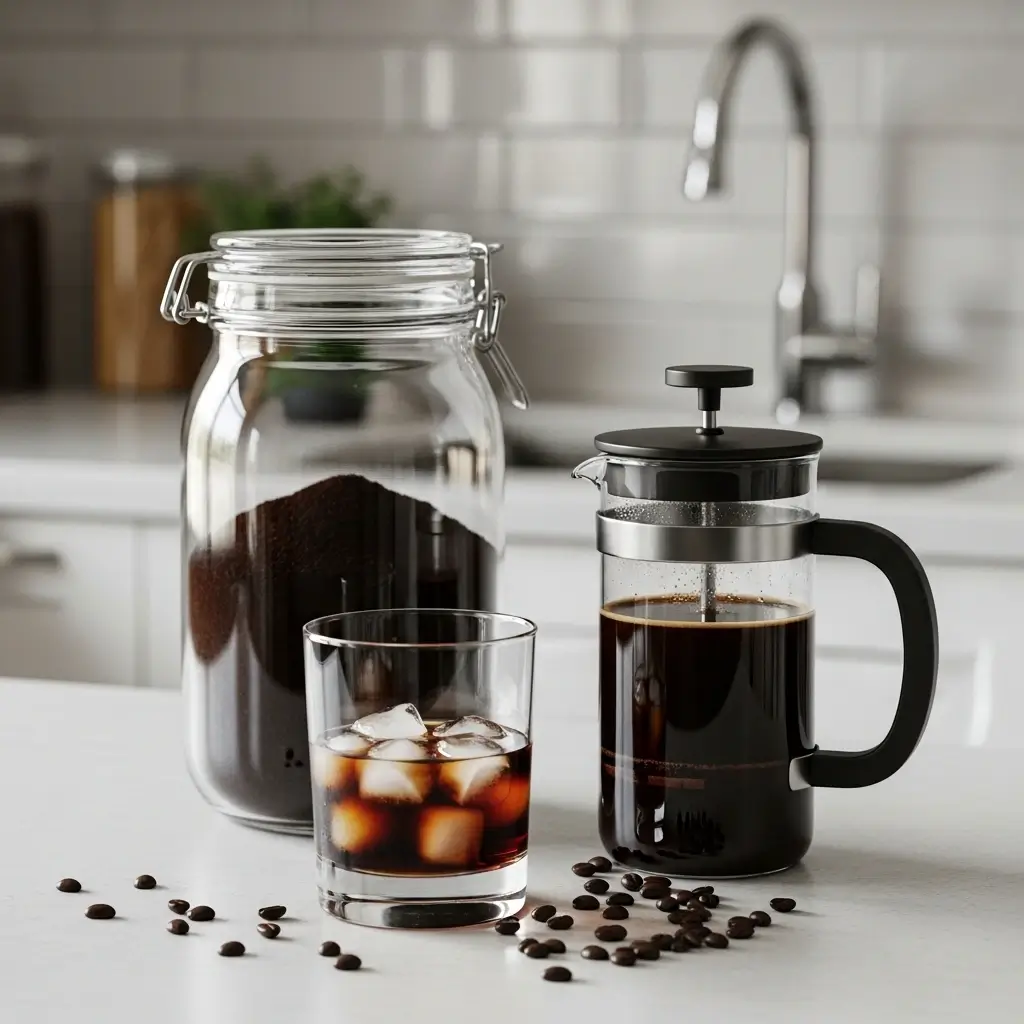INTRODUCTION:
Chilled coffee drinks have taken the world by storm, especially in warmer months. Among these, Cold Brew vs Iced Coffee reign supreme, but many people get confused about what sets them apart. Both are cold, both are delicious—but their flavors, preparation, and caffeine kick are quite different.
This guide dives deep into cold brew and iced coffee to help you decide which is best for your taste, lifestyle, and caffeine needs. From flavor profiles to easy at-home brewing methods, health considerations, and caffeine content, we cover everything you need to become an expert on these refreshing coffee options.

1. Understanding Cold Brew and Iced Coffee: What Makes Them Different?
1.1 What Is Cold Brew Coffee?
Cold brew is made by soaking coarsely ground coffee beans in cold water for a long time—usually 12 to 24 hours. This slow extraction process pulls out rich coffee flavors while minimizing bitterness and acidity. The result is a smooth, mellow concentrate that you can dilute with milk or water before serving over ice.
This brewing method has gained immense popularity for its gentle taste and convenience (since you can batch make it ahead of time). Because it’s steeped rather than brewed with heat, cold brew retains more subtle chocolatey, nutty notes.
1.2 What Is Iced Coffee?
Iced coffee, by contrast, is brewed hot—using drip, espresso, or pour-over methods—and then rapidly chilled by pouring it over ice. This process preserves the bright, acidic notes of coffee, giving it a lively, bold flavor.
Since iced coffee is brewed hot and cooled, it usually tastes sharper and more vibrant than cold brew. It’s also quicker to make if you want a cold coffee fix in a hurry.
1.3 Key Differences in Preparation and Flavor
Cold brew relies on time and cold water to extract flavors slowly, creating a smooth, low-acid concentrate. Iced coffee uses traditional hot brewing methods, delivering a brighter, more acidic taste.
Cold brew needs hours of steeping but offers ready-to-drink concentrate you can batch prepare. Iced coffee takes minutes to brew but is best enjoyed fresh immediately after cooling.

2. Exploring Flavor Profiles: Which One Matches Your Palate?
2.1 Smooth, Low-Acid Cold Brew
Cold brew is beloved for its smooth, mellow taste. The long, cold steeping reduces the natural acidity and bitterness found in hot-brewed coffee, making it ideal for those sensitive to acidity or looking for a gentle coffee experience.
Its flavor often features rich chocolate and nutty undertones with a silky mouthfeel. Because cold brew is usually diluted before drinking, you can control the intensity and creaminess by adjusting the water or milk ratio.
2.2 Bright, Tangy Iced Coffee
Iced coffee delivers a brighter flavor with lively acidity and vibrant aromatics. The hot brew extracts more complex compounds rapidly, including fruity and floral notes that cold brew’s slow process sometimes smooths over.
If you enjoy a coffee with a tangy punch and sharper finish, iced coffee is a great choice. It pairs well with bold additions like flavored syrups or a splash of citrus.
2.3 Sweeteners and Creamers
Both drinks shine with additions, but the flavor combos differ:
- Cold brew pairs beautifully with creamy ingredients—milk, oat milk, cream, or vanilla syrup—to complement its smoothness.
- Iced coffee’s bright profile stands up well to spiced syrups, caramel, or cinnamon, which enhance its lively notes.

3. Brewing At Home: Step-By-Step Guide for Cold Brew and Iced Coffee
3.1 How to Make Cold Brew Coffee at Home
Ingredients:
- 1 cup coarsely ground coffee beans
- 4 cups cold, filtered water
Instructions:
- Place coffee grounds in a large jar or pitcher.
- Pour cold water over grounds and stir gently to fully saturate.
- Cover and refrigerate for 12 to 24 hours to steep.
- Strain the mixture through a fine mesh sieve or coffee filter to remove grounds.
- Dilute the resulting concentrate with water or milk according to your taste.
- Serve over ice for a refreshing, smooth drink.
Pro tip: Use coarse grounds to avoid over-extraction and bitterness. Make a batch once, and store in the fridge for up to two weeks.
3.2 How to Make Iced Coffee at Home
Ingredients:
- 1 cup hot brewed coffee (drip, espresso, or pour-over)
- Ice cubes
- Milk, creamer, or sweetener (optional)
Instructions:
- Brew your coffee using your preferred method.
- Let it cool slightly or chill in the fridge for quicker cooling.
- Fill a glass with ice cubes.
- Pour cooled coffee over the ice.
- Add milk, creamer, or sweetener if desired.
- Stir well and enjoy immediately.
Pro tip: To prevent watering down your coffee as the ice melts, try using coffee ice cubes made by freezing brewed coffee in an ice tray.
3.3 Equipment and Time Needed
Cold brew requires minimal equipment—just a jar or pitcher and a filter—but takes 12+ hours, so planning ahead is key. Iced coffee needs standard coffee gear and ice and can be ready in minutes, perfect for quick fixes.

4. Health and Caffeine Insights: What to Know Before You Choose
4.1 Caffeine Content: Which Has More?
Cold brew often contains more caffeine per ounce due to its concentrated steeping process. However, since it’s typically diluted before drinking, the caffeine per serving can be comparable to iced coffee.
Iced coffee’s caffeine depends on the brewing method and coffee-to-water ratio but generally delivers a moderate caffeine kick with faster onset.
4.2 Acidity and Stomach Sensitivity
Cold brew’s low acidity makes it gentler on the stomach and a better option for those with acid reflux or sensitive digestion.
Iced coffee, brewed hot, retains more acids that can irritate some people’s stomachs or cause heartburn.
4.3 Calories and Add-Ins
Pure black cold brew and iced coffee have almost zero calories. However, most people add sweeteners, creamers, or flavored syrups which can quickly increase calorie content. For a healthier choice, opt for sugar-free syrups and plant-based milks.

5. How to Choose the Right One for You
5.1 Taste Preference: Smooth or Bold?
If you prefer smooth, low-acid coffee with mellow, chocolatey notes, cold brew is your go-to. If you enjoy bright, tangy flavors and classic coffee acidity, iced coffee will delight you.
5.2 Time and Convenience
Cold brew requires planning and time for steeping, but you can batch make it for several days of ready-to-drink coffee. Iced coffee is quicker but best consumed fresh.
5.3 Lifestyle and Caffeine Needs
Cold brew’s concentrated caffeine provides sustained energy, perfect for long workdays or steady focus. Iced coffee offers a quicker caffeine boost for shorter bursts.
5.4 Experiment and Customize
Try both at home, adjusting coffee strength, sweetness, and creaminess to find your perfect chilled coffee. Consider trying flavored syrups, alternative milks, or even coffee ice cubes to enhance your experience.
CONCLUSION:
Choosing between Cold Brew vs Iced Coffee depends on your flavor preference, caffeine needs, and schedule. Cold brew impresses with smoothness, low acidity, and batch-making convenience, while iced coffee excels in bold, bright flavor and quick preparation.
With this guide, you’re ready to brew both drinks at home and find your perfect refreshing coffee. Whether you want a mellow chill or a bright pick-me-up, cold brew and iced coffee both offer delicious ways to stay energized and cool.
👉 Explore More Iced Coffee Recipes and Tips at The Iced Coffee



